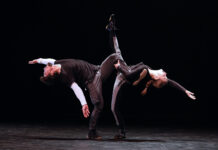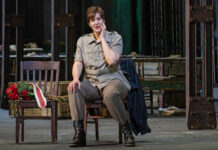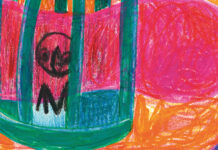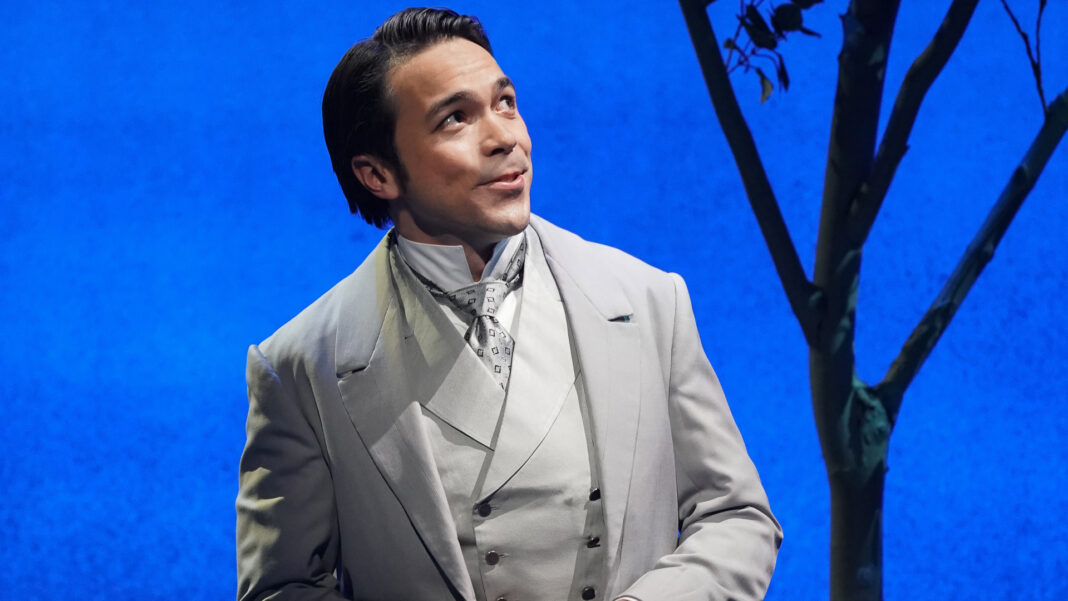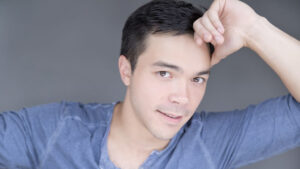
There’s an old saying that there are no small roles, only small actors. But sometimes the right combination of actor and role, regardless of size, can have ripple effects that extend beyond the stage itself and into the real world. Enter Sam Simahk.
He’s currently playing the role of Freddy Eynsford-Hill in the touring production of My Fair Lady. The show, which is currently playing at the Segerstrom Center for the Arts in Costa Mesa, continues across the United States through August.
Hill is a character who is immediately smitten with Eliza Doolittle in the musical. Though he’s upper-class and Eliza is a cockney flower girl being groomed by Professor Henry Higgins to present as well above her status, Hill can’t help but want to spend every possible moment on the street where she lives.
As with all the actors who have played this role in the 2018 Broadway revival, Simahk represents a departure from traditional casting of the role. He told me just before the holidays his mother is “a New Englander with lineage on the Mayflower. And my dad is an immigrant from Thailand.”
The last thing he thought he’d do is play roles traditionally portrayed by white actors.
“I came out of college thinking I’m going to be cast in The King and I and Miss Saigon. And here are the other ethnicities that I can pretend to be on stage: I can probably play Latino. I can maybe play Italian. Maybe Middle Eastern – this is the frame of mind that I had coming into the industry and now things are flipped on their head. People are actively trying to cast nontraditionally and trying to to cast with diversity in mind. Granted, we’re making baby steps.”

Simahk’s timing couldn’t have been better. He’s been cast as Curly in Oklahoma!, Sky Masterson in Guys and Dolls and Anthony Hope in Sweeney Todd.
“Even if I’m from the backwoods of Massachusetts personality-wise, I’m more like Curly than the King of Siam. I have more of a cultural understanding of what it’s like to be Curly. I have cattle ropers in the family, for instance. So even though I understand that experience, casting directors 10-15 years ago, were not thinking that I had that experience because of the way that I looked. And audiences don’t expect me to have that experience, you know? But things are changing and I’m just so glad to be able to tackle that.”
He’s also tackling what might best be described as his character’s inherent creepiness, at least as judged by contemporary standards.
“In the post MeToo era I think it’s very tricky to have a guy waiting outside of a girl’s house for months. In the ’50s that was romantic. In today’s society it is creepy and weird. So how do you approach it? I think if you approach that purely through romantic means, if it comes from a genuine naivete and a sweetness, it softens the stalker-ism a little bit.”
Simahk believes it is best to approach a work like this from multiple perspectives.
“When it comes to the classics I think you have to look at it through three different lenses. The first is the literal. I think when most people see a show, they’re thinking they see it in a literal sense. We’re in 1913 London and there was a cockney flower girl who meets a professor of linguistics. This is the story that comes out and that’s literal. I think you have to view it through the lens from which it was written – 1956 New York. What’s going on at that point? Women have the right to vote, but they’re still not allowed in the workplace. And so that that comes out of that period. Then the third lens to look at it through is the lens through which it’s produced currently. I think it’s important to bring back these works that have a good amount of misogyny baked into them because of the culture that they came from. We view the way that we’ve changed as a society and the ways that we haven’t changed as a society. We need to think about how often are we Henry Higgins? And how often are we Eliza? And when can we be more like Pickering or Freddy?”
An additional way Simahk looks at it is how younger audiences might view him in this role and what that might mean to them.
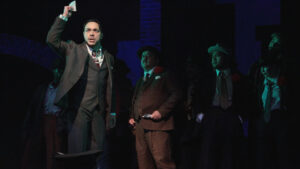
“Some nights I look out and there’s an Asian family sitting in the front row with little kids and it just makes me really proud to be up there. This is good representation to show a kid – a kid who loved doing theater. Yes, you can be an actor and you don’t have to play a guy that works at a Chinese laundry. You can be a prince, you can be a cowboy, you can be a rich boy from Upper Class England. You don’t have to adhere to these stereotypes that have been set up for us for 100 years and more.
“That’s great for the kids, but I also think it’s necessary for the adults and for the country to see us on stage. To see black, brown, yellow, red, see people of all colors on stage and remind people that we are a part of the fabric of this country as well.”
George Bernard Shaw, whose play Pygmalion inspired My Fair Lady, said, “Life isn’t about finding yourself. Life is about creating yourself.” It’s a concept with which Simahk whole-heartedly agrees as he pursues not just a career, but a better industry.
“We all have flaws and I think we all try to be better. I think we all need to work at that. We all need to fight the demons and we all have demons of some sort. We all need to fight those demons because the world changes and the world adapts. And if we don’t adapt with it, then we die. I think that if every individual worked harder at adapting to a changing world then society would work along with those individuals. I don’t think that I’m perfect. I think I’m an incredibly flawed human being, but I try and fight those flaws as much as I can. I try and recognize them and give them space. Then I push past them – I hope to push past them. That’s all any of us can hope for.”
For details and tickets for the My Fair Lady national tour, please go here.
Photo: Sam Simahk in My Fair Lady (Photo by Joan Marcus/Courtesy Segerstrom Center for the Arts)



